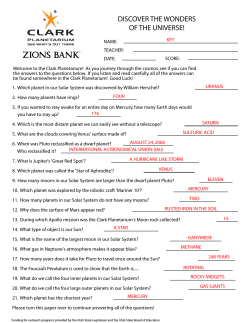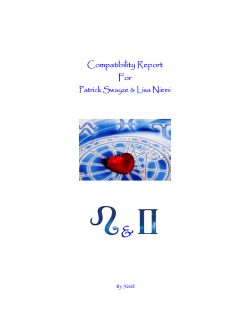
Document 174037
Uranus Compiled by Donnette E Davis www.staidenshomeschool.com Our Solar System Uranus Uranus Facts: • • • • • Uranus as seen from Voyager 2 • Uranus's rings look white in pictures, but they are really made of asphalt-coloured material. When it was first discovered, Uranus was mistaken for a star. It was named "34 Tauri". Uranus rotates on its side It is the only planet to do so. Uranus is the only planet to be named after a Greek god, not a Roman one. Uranus, the seventh planet from the Sun, was discovered by William Herschel on March 13, 1781. When William Herschel discovered Uranus, he at first thought he had discovered a comet. Uranus is one of the smaller gas giants in our solar system, but it is still large enough to hold 64 planets the size of Earth. Uranus tilts over so far on its axis that it rotates on its side. Because of this, its poles are sometimes pointed almost directly at the Sun. Uranus' atmosphere is made up of hydrogen, helium, and methane. The temperature in the upper atmosphere is very cold. The cold methane gas is what gives Uranus its blue-green colour. The rapid rotation of Uranus causes winds up to 600 kilometres per hour to blow in its atmosphere. Uranus has eleven known rings which contain dark, boulder-sized particles. Uranus has 27 named moons. Some of these moons are less than 100 kilometres wide and black as coal. St Aiden’s Homeschool © 2009 ~ All Rights Reserved Donnette E Davis 99 Our Solar System How big is Uranus? Comparison of the size of Uranus and the Earth Uranus is 51,118 kilometers or about four Earths wide. It is the third widest and fourth heaviest planet in the Solar System. What is the surface of Uranus like? Uranus does not have a surface that you could stand on without going deep into the atmosphere. Under the atmosphere, there may be an even mixture of rock and ice. What are the rings around Uranus like? Uranus has eleven rings. They are dark in colour and very hard to see. They were discovered by accident in 1977. Scientists were studying a bright star near Uranus. However, the star's light was blocked before and after it disappeared behind Uranus. From this, they figured out that Uranus has a ring system. Uranus' Satellites Uranus has 21 named moons and six unnamed ones: • Unlike the other bodies in the solar system which have names from classical mythology, Uranus' moons take their names from the writings of Shakespeare and Pope. St Aiden’s Homeschool © 2009 ~ All Rights Reserved Donnette E Davis 100 Our Solar System • • They form three distinct classes: the 11 small very dark inner ones discovered by Voyager 2, the 5 large ones (right), and the newly discovered much more distant ones. Most have nearly circular orbits in the plane of Uranus' equator (and hence at a large angle to the plane of the ecliptic); the outer 4 are much more elliptical. What are its moons like? Uranus's rings and moons Uranus has 27 known moons, which places it third in the Solar System for number of moons! The five main ones are Miranda, Ariel, Umbriel, Titania and Oberon. Miranda Miranda is the smallest and closest of Uranus's major moons. It is mainly made of ice and rock. Miranda's surface has grooves, cliffs, and valleys. The moon was named after a character in The Tempest, a play by Shakespeare. Ariel Ariel is made of rock and ice. Ariel has many valleys, but not many craters. Ariel was named after a character in the poem The Rape of the Lock by Alexander Pope. Ariel is also a spirit in The Tempest by Shakespeare. Umbriel Umbriel is made of lots of ices and some rock. It is also the darkest of Uranus's major moons. Umbriel was named after a character in the poem The Rape of the Lock by Alexander Pope. Titania Titania is the largest moon of Uranus. It is mostly ice and rock. The surface is covered with canyons. It was named after the Queen of the Fairies in A Midsummer's Night Dream, a play by Shakespeare St Aiden’s Homeschool © 2009 ~ All Rights Reserved Donnette E Davis 101 Our Solar System Oberon Oberon is the outermost of the major moons of Uranus. It is made of the same things as Titania. It has many craters. Some of them have white rays around them and dark crater floors. It was named after the King of the Fairies in A Midsummer's Night Dream. Other Moons There are 13 tiny moons known to be orbiting Uranus inside Miranda's orbit. Nine more tiny moons are known to be in big orbits beyond Oberon's orbit. How long is a day on Uranus? One day on Uranus is about 27 Earth hours long. Uranus spins on its side, maybe because of a big impact early in the history of the Solar System. How long is a year on Uranus? One year on Uranus would be 30,708 days or 84 years on Earth. What is Uranus made of? Unlike Jupiter and Saturn, Uranus is thought to be made mostly of rock and ice. The gases in its atmosphere are mostly hydrogen and helium. Other gases found in smaller amounts are ammonia, water, and methane. Uranus' blue colour comes from methane clouds, which absorb red light and reflect blue light. How much would Uranus's gravity pull on me? If you were floating close to the cloud tops of Uranus, you would be pulled down with a force about 86% of Earth's gravity. Who is Uranus named after? Uranus was named after Ouranos, the Greek name for the sky. According to Greek mythology, Uranus is the ancient Greek deity of the Heavens, the earliest supreme god. Uranus was the son and mate of Gaia, Mother Earth the father of Cronus (Saturn) and of the Cyclopes and Titans (predecessors of the Olympian gods). St Aiden’s Homeschool © 2009 ~ All Rights Reserved Donnette E Davis 102 Our Solar System Who Discovered Uranus? Uranus, the first planet discovered in modern times, was discovered by William Herschel while systematically searching the sky with his telescope on March 13, 1781. It had actually been seen many times before but ignored as simply another star (the earliest recorded sighting was in 1690 when John Flamsteed catalogued it as 34 Tauri). Herschel named it "the Georgium Sidus" (the Georgian Planet) in honour of his patron, the infamous (to Americans) King George III of England; others called it "Herschel". The name "Uranus" was first proposed by Bode in conformity with the other planetary names from classical mythology but didn't come into common use until 1850. Uranus has been visited by only one spacecraft, Voyager 2 on Jan 24 1986. Voyager 2 discovered 10 small moons in addition to the 5 large ones already known. It is likely that there are several more tiny satellites within the rings. Uranus is sometimes just barely visible with the unaided eye on a very clear night; it is fairly easy to spot with binoculars (if you know exactly where to look). A small astronomical telescope will show a small disk. There are several Web sites that show the current position of Uranus (and the other planets) in the sky, but much more detailed charts will be required to actually find it. Such charts can be created with a planetarium program. St Aiden’s Homeschool © 2009 ~ All Rights Reserved Donnette E Davis 103 Our Solar System Fact Sheet St Aiden’s Homeschool © 2009 ~ All Rights Reserved Donnette E Davis 104 Our Solar System Describe Uranus. ____________________________________________________ ____________________________________________________ ____________________________________________________ ____________________________________________________ ____________________________________________________ ____________________________________________________ ____________________________________________________ ____________________________________________________ ____________________________________________________ How big is it? ____________________________________________________ ____________________________________________________ ____________________________________________________ What is its surface like? ____________________________________________________ ____________________________________________________ ____________________________________________________ ____________________________________________________ ____________________________________________________ ____________________________________________________ ____________________________________________________ ____________________________________________________ ____________________________________________________ St Aiden’s Homeschool © 2009 ~ All Rights Reserved Donnette E Davis 105 Our Solar System Why is there no life on Uranus? ____________________________________________________ ____________________________________________________ ____________________________________________________ ____________________________________________________ ____________________________________________________ ____________________________________________________ ____________________________________________________ ____________________________________________________ ____________________________________________________ How many Moons does Uranus have? ____________________________________________________ ____________________________________________________ ____________________________________________________ How long is a day and a year on this planet? ____________________________________________________ ____________________________________________________ ____________________________________________________ What is Uranus made of? ____________________________________________________ ____________________________________________________ ____________________________________________________ St Aiden’s Homeschool © 2009 ~ All Rights Reserved Donnette E Davis 106 Our Solar System How much would Uranus’s gravity pull on me? ____________________________________________________ ____________________________________________________ ____________________________________________________ Who is Uranus named after? ____________________________________________________ ____________________________________________________ ____________________________________________________ ____________________________________________________ Discuss important dates concerning Uranus. Refer to the handout on the previous pages. ____________________________________________________ ____________________________________________________ ____________________________________________________ ____________________________________________________ ____________________________________________________ ____________________________________________________ ____________________________________________________ ____________________________________________________ ____________________________________________________ ____________________________________________________ ____________________________________________________ ____________________________________________________ ____________________________________________________ ____________________________________________________ St Aiden’s Homeschool © 2009 ~ All Rights Reserved Donnette E Davis 107 Our Solar System What are its rings like? ____________________________________________________ ____________________________________________________ What are its moons like? ____________________________________________________ ____________________________________________________ • Miranda ____________________________________________________ ____________________________________________________ • Arial ____________________________________________________ ____________________________________________________ • Umbriel ____________________________________________________ ____________________________________________________ • Titania ____________________________________________________ ____________________________________________________ • Oberon ____________________________________________________ ____________________________________________________ • Other moons ____________________________________________________ ____________________________________________________ ____________________________________________________ St Aiden’s Homeschool © 2009 ~ All Rights Reserved Donnette E Davis 108
© Copyright 2025









